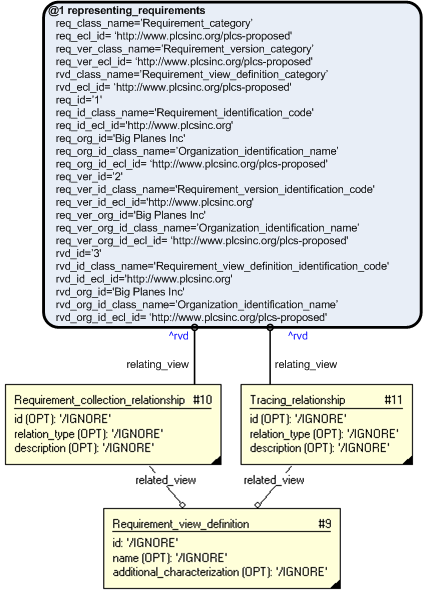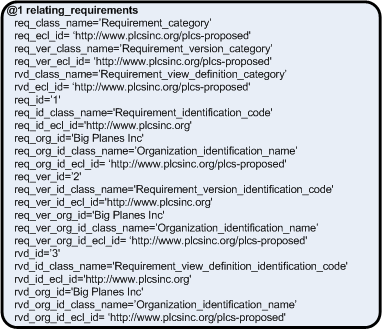Template:— relating_requirements (req_rel)
Capability:representing_requirements |
Date: 2009/04/09 15:05:20
Revision: 1.11
|
This section specifies the template relating_requirements.
NOTE
The template has been defined in the context of the capability
representing_requirements
which provides an overall description of the
relevant parts of the ISO 10303-239 information model and a description
of related templates.
NOTE
An explanation of a template and the associated instantiation path is
provided in the
Template overview
section.
This template describes the creation of relationships between requirements.
The EXPRESS-G diagram in
Figure
shows the templates and EXPRESS entities that are required
to represent the template
"relating_requirements".
The text highlighted in blue shows the template parameters.
Figure 18 — Relating requirements (EXPRESS-G diagram)
The graphic for the template to be used in other EXPRESS-G diagrams
is shown in Figure
below.
Figure 19 — Sourcing requirements (condensed EXPRESS-G diagram)
The following input parameters are defined for this template:
The identifier assigned to a requirement.
The classification of the identifier assigned to a requirement.
The following classes and their sub-classes can be used:
The identifier assigned to an organization that assigns an identifier to a requirement.
The identifier assigned to a requirement version.
The classification of the identifier assigned to a requirement version.
The following classes and their sub-classes can be used:
The identifier assigned to an organization that assigns an identifier to a requirement version.
The identifier assigned to a requirement view definition.
The classification of the identifier assigned to a requirement view definition.
The following classes and their sub-classes can be used:
classifications: [Requirement_view_definition_identification_code]![[warning:]](../../../../images/dex/warning.gif) Error RDL1: The class Requirement_view_definition_identification_code does not exist in RDL at urn urn:plcs:rdl:std. Check
the dexlib/data/refdata/rdl_index.xml
Error RDL1: The class Requirement_view_definition_identification_code does not exist in RDL at urn urn:plcs:rdl:std. Check
the dexlib/data/refdata/rdl_index.xml
The identifier assigned to an organization that assigns an identifier to a requirement view definition.
The following classes and their sub-classes can be used:
The following classes and their sub-classes can be used:
The requirement_view_definition corresponding to the requirement collection member.
The requirement_view_definition corresponding to the requirement collection.
The following reference parameters are defined for this template:
Allow the
Requirement
entity instantiated in this path to be referenced when this template is used.
Note: The
Requirement
entity can be referenced in a template path by:
%^target = $relating_requirements.req%
where
target
is the parameter to which the
Requirement
is bound.
Allow the
Requirement_version
entity instantiated in this path to be referenced when this template is used.
%^target = $relating_requirements.req_ver%
%^target = $relating_requirements.rvd%
%^target = $relating_requirements.vdc%
%^target = $relating_requirements.req_col_rel%
Allow the
Tracing_relationship
entity instantiated in this path to be referenced when this template is used.
%^target = $relating_requirements.trc_rel%
The instantiation path shown below specifies the entities that are to be
instantiated by the template.
A description of templates and the syntax for the instantiation path is
provided in the
Templates Help/Information section.
-- Instantiate a Requirement entity. Requirement-- Bind the Requirement entity to the parameter ^req. %^req =
Requirement%
-- Identify the Requirement /
assigning_identification(
items=^req,
id=@req_id,
id_class_name=@req_id_class_name,
id_ecl_id=@req_id_ecl_id)/
-- Instantiate a Requirement_version entity and link it to Requirement.
^req <-
Requirement_version.of_product-- Bind the Requirement_version entity to the parameter ^req_ver. %^req_ver =
Requirement_version%
-- Identify the Requirement_version /
assigning_identification(
items=^req_ver,
id=@req_ver_id,
id_class_name=@req_ver_id_class_name,
id_ecl_id=@req_ver_id_ecl_id)/
-- Instantiate the View_definition_context. View_definition_contextView_definition_context.application_domain = '/IGNORE'
View_definition_context.life_cycle_stage = '/IGNORE'
View_definition_context.description = '/IGNORE'
-- Bind the View_definition_context entity to the parameter ^vdc. %^vdc =
View_definition_context%
-- Classify the View_definition_context /
assigning_reference_data(
items=^vdc,
class_name=@vdc_ad_class_name,
ecl_id=@vdc_ad_ecl_id)/
/
assigning_reference_data(
items=^vdc,
class_name=@vdc_lcs_class_name,
ecl_id=@vdc_lcs_ecl_id)/
-- Instantiate a Requirement_view_definition entity and link it to a Requirement_version and to the View_definition_context.
^req_ver <-
Requirement_view_definition.defined_version
^vdc <-
Requirement_view_definition.initial_context-- Bind the Requirement_view_definition entity to the parameter ^rvd. %^rvd =
Requirement_view_definition%
-- Identify the Requirement_view_definition. /
assigning_identification(
items=^rvd,
id=@rvd_id,
id_class_name=@rvd_id_class_name,
id_ecl_id=@rvd_id_ecl_id)/
-- Instantiate a Requirement_collection_relationship entity and link it to two Requirement_view_definition objects.
^rvd <-
Requirement_collection_relationship.collection
^rvd <-
Requirement_collection_relationship.memberRequirement_collection_relationship.id = '/IGNORE'
Requirement_collection_relationship.relation_type = '/IGNORE'
Requirement_collection_relationship.description = '/IGNORE'
-- Bind the Requirement_collection_relationship entity to the parameter ^req_col_rel %^req_col_rel =
Requirement_collection_relationship%
-- Instantiate a Tracing_relationship entity and link it to two Requirement_view_definition objects.
^rvd <-
Tracing_relationship.traces_from
^rvd <-
Tracing_relationship.traces_toTracing_relationship.id = '/IGNORE'
Tracing_relationship.relation_type = '/IGNORE'
Tracing_relationship.description = '/IGNORE'
-- Bind the Tracing_relationship entity to the parameter ^trc_rel %^trc_rel =
Tracing_relationship%
The following entities are instantiated with attributes as specified:
The instance diagram in Figure
shows an example of the EXPRESS entities and templates that are instantiated by the template:
/relating_requirements(req_id='1', req_ver_id='2', rvd_id='3', req_id_class_name='Requirement_identification_code', req_ver_id_class_name='Progression_identification_code', rvd_id_class_name='Requirement_view_definition_identification_code', req_id_ecl_id='http://www.plcsinc.org/plcs-proposed', req_ver_id_ecl_id='http://www.plcsinc.org/plcs-proposed', rvd_id_ecl_id='http://www.plcsinc.org/plcs-proposed', req_org_id_ecl_id='http://www.plcsinc.org/plcs-proposed', req_ver_org_id_ecl_id='http://www.plcsinc.org/plcs-proposed', rvd_org_id_ecl_id='http://www.plcsinc.org/plcs-proposed', req_class_name='Requirement_category', req_ver_class_name='Requirement_version_category', rvd_class_name='Requirement_view_definition_category', req_ecl_id='http://www.plcsinc.org/plcs-proposed', req_ecl_id='http://www.plcsinc.org/plcs-proposed', rvd_ecl_id='http://www.plcsinc.org/plcs-proposed')/
(an illustration of the consolidated relating_requirements template is shown in
Figure
below.)
Figure 20 — Relating requirements (EXPRESS-I diagram)
The instance diagram in
Figure
shows the graphic symbol for the template that is to be
used in other instance diagrams. The example template is:
/relating_requirements(req_id='1', req_ver_id='2', rvd_id='3', req_id_class_name='Requirement_identification_code', req_ver_id_class_name='Progression_identification_code', rvd_id_class_name='Requirement_view_definition_identification_code', req_id_ecl_id='http://www.plcsinc.org/plcs-proposed', req_ver_id_ecl_id='http://www.plcsinc.org/plcs-proposed', rvd_id_ecl_id='http://www.plcsinc.org/plcs-proposed', req_org_id_ecl_id='http://www.plcsinc.org/plcs-proposed', req_ver_org_id_ecl_id='http://www.plcsinc.org/plcs-proposed', rvd_org_id_ecl_id='http://www.plcsinc.org/plcs-proposed', req_class_name='Requirement_category', req_ver_class_name='Requirement_version_category', rvd_class_name='Requirement_view_definition_category', req_ecl_id='http://www.plcsinc.org/plcs-proposed', req_ecl_id='http://www.plcsinc.org/plcs-proposed', rvd_ecl_id='http://www.plcsinc.org/plcs-proposed')/
Figure 21 — Relating requirements (condensed EXPRESS-I diagram)
Characterizations
No common characterizations of the template
relating_requirements
have been identified. However, the ISO 10303-239 EXPRESS model
may enable other assignments to the entities instantiated by the template.




